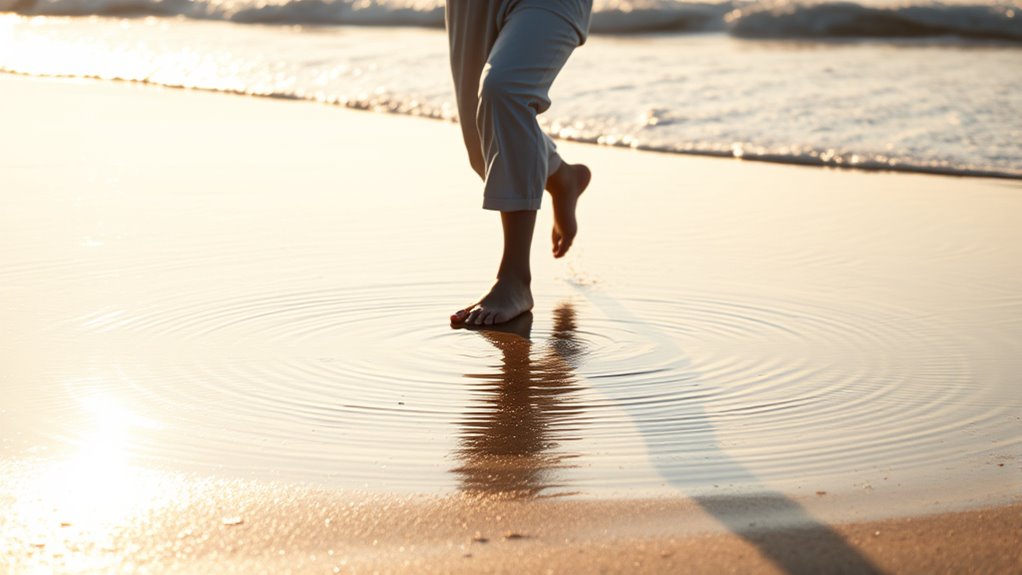Practicing Tai Chi on wet sand challenges your balance and enhances stability by requiring you to adapt to shifting, uneven surfaces. It activates your core muscles through dynamic movements and sharpens proprioception, improving body awareness and coordination. As you focus on subtle shifts and sensations, your mind-body connection deepens, boosting confidence in unsteady environments. Continuing will reveal more ways this natural setting helps cultivate resilience, mindfulness, and overall well-being.
Key Takeaways
- Practicing Tai Chi on wet sand enhances proprioception and body awareness through shifting surfaces.
- It improves balance and stability by challenging the body to adapt to uneven, unstable terrain.
- Wet sand’s resistance encourages controlled movements, strengthening core muscles and coordination.
- The natural environment promotes mindfulness and sensory awareness, deepening focus and internal harmony.
- Dynamic shifts on wet sand boost resilience, adaptability, and injury prevention in Tai Chi practice.
Enhancing Stability on an Unpredictable Surface

Practicing Tai Chi on wet sand requires you to stay alert and adapt quickly to the shifting surface. As you move, you’ll notice how unstable ground challenges your balance and forces you to stay grounded. To enhance stability, focus on your foot placement, ensuring each step is deliberate and controlled. Keep your knees slightly bent to absorb the unevenness and maintain a low center of gravity. Engage your leg muscles actively to counteract slips or tilts. Your awareness of subtle shifts in the sand helps you adjust your posture instantly. This constant need for adaptation trains your nervous system to respond faster and more precisely, improving your overall stability. Regular practice on such surfaces can also boost your proprioception, leading to better body awareness and coordination. Developing body awareness through this practice enhances your ability to detect and correct imbalances more effectively. Over time, these skills transfer to more solid surfaces, boosting your confidence and control in everyday movements.
Strengthening Core Muscles Through Dynamic Movements

Moving across uneven, shifting sand challenges your stability and forces you to engage your core muscles constantly. As you practice Tai Chi on wet sand, dynamic movements like shifting weight or sweeping arm motions activate your core muscles more intensely. These movements require you to stabilize your spine and pelvis, making your core work harder. To visualize this, consider the following:
| Movement Type | Core Activation Effect |
|---|---|
| Slow, Controlled Stances | Builds endurance in deep core muscles |
| Rapid, Dynamic Shifts | Enhances reactive strength and stability |
| Balance Poses | Improves coordination between core and limbs |
| Arm Swings | Engages obliques and transverse abdominis |
Additionally, understanding Gold IRA Rollovers can provide insight into how diversifying your assets might support your overall financial stability. Incorporating core engagement techniques during your practice can further amplify these benefits by promoting better muscle memory and control. Engaging your stability muscles consistently helps improve your overall balance and posture during Tai Chi. Proper core muscle activation is essential for maintaining proper form and preventing injury during dynamic movements. Developing core endurance can also help sustain your balance over longer practice sessions.
Improving Proprioception and Body Awareness

Since uneven, shifting sand constantly challenges your stability, focusing on proprioception and body awareness becomes essential to maintaining control. As you practice Tai Chi, you’ll tune into how your muscles, joints, and skin send signals about your position in space. This heightened awareness helps you make small adjustments instantly, preventing falls or wobbling. On wet sand, every step requires you to feel subtle shifts beneath your feet, encouraging you to develop a more refined sense of balance. You learn to trust your body’s internal cues rather than relying solely on sight. Additionally, engaging in such practices can improve your overall body awareness and coordination. Over time, this improved proprioception enhances your overall coordination and stability, making you more responsive to unpredictable terrains and better equipped to keep your balance in daily life. Incorporating Cultural Intelligence during such practices encourages greater mindfulness and adaptability in diverse environments. Furthermore, developing sensory integration by combining visual, tactile, and kinesthetic cues can deepen your connection to the present moment and improve your balance skills. Introducing awareness of proprioception itself can also foster greater confidence in navigating various challenging surfaces.
Developing Greater Adaptability in Balance Techniques

As you adapt to the shifting surface of wet sand, you learn to modify your balance techniques dynamically rather than relying on a fixed method. You become more aware of subtle changes beneath your feet and adjust your weight distribution accordingly. This flexibility requires you to stay alert and respond quickly to instability, strengthening your ability to maintain equilibrium in unpredictable conditions. Instead of rigidly sticking to one stance, you experiment with small adjustments, shifting your center of gravity as needed. Over time, this process enhances your overall balance resilience, making you more capable of handling uneven or unstable surfaces in daily life. Developing this adaptability not only improves your Tai Chi practice but also cultivates a more responsive, resilient approach to movement. Incorporating balance training into your routine further enhances these skills by challenging your stability in varied situations. Recognizing the importance of reliable payment systems in daily transactions can also support your focus and confidence during physical and mental exercises. Additionally, practicing on diverse surfaces like wet sand helps simulate real-world conditions, reinforcing the adaptability of your balance skills. Engaging in varied training environments can further boost your ability to stay balanced across different scenarios. For example, understanding how to safely use appropriate footwear on different terrains can contribute to better balance and safety.
Connecting Mind and Body in Natural Settings

Practicing Tai Chi in natural settings helps you strengthen the connection between your mind and body. As you move with the environment, you begin to embrace nature’s calm and focus more deeply. This harmony enhances your overall practice and deepens your awareness of the present moment. Incorporating mindfulness techniques into your practice can further amplify these benefits by promoting greater concentration and emotional stability. Additionally, practicing in natural settings may evoke visions or feelings that align with prophetic dreams, fostering a deeper spiritual connection during your practice. Engaging with your environment can also heighten your awareness of dream symbolism, enriching your understanding of subconscious messages. Being aware of potential food toxins like grapes and ensuring your environment is safe can also support a balanced and healthful practice. Recognizing the influence of home security systems can help you create a safe space that encourages mindful practice and inner peace.
Enhancing Mind-Body Connection
Connecting your mind and body in natural settings like wet sand offers a uniquely immersive way to deepen your Tai Chi practice. As you move through the gentle motions, focus on how your body responds to the uneven surface beneath your feet. Feel the sensation of each step, the shifting sand, and how it challenges your stability. This heightened awareness encourages you to stay present, honing your ability to listen to your body’s signals. By syncing your breath with your movements, you cultivate a deeper sense of harmony between your mental focus and physical actions. Practicing in such a dynamic environment pushes you to adapt and refine your balance, ultimately strengthening your mind-body connection and enhancing your overall Tai Chi experience. Incorporating body awareness exercises can further amplify these benefits by sharpening your sensitivity to subtle physical cues. Additionally, embracing neural network principles in your practice can help improve your adaptability and response to environmental changes. Recognizing the importance of sensory perception can deepen your engagement with the natural surroundings, enriching your practice even further.
Embracing Nature’s Calm
Immersing yourself in natural settings like the beach or a quiet forest creates an ideal environment to unify your mind and body through Tai Chi. The gentle sounds of waves or rustling leaves help quiet mental chatter, allowing you to focus inward. As you move slowly and deliberately, you connect with the environment around you, grounding your movements in the natural rhythm of nature. Breathing deeply in fresh air enhances your sense of calm and presence. Nature’s tranquility encourages mindfulness, helping you release stress and cultivate inner peace. Practicing outdoors makes you more aware of your body’s sensations and your surroundings. This harmony between your physical movements and the natural world deepens your overall sense of balance and well-being.
Cultivating Mindfulness During Movement Practice

As you move on the wet sand, focus on your senses to heighten your awareness of the environment. Stay present with each breath and intentional movement, letting distractions fade away. This mindfulness deepens your inner calm and sharpens your focus throughout your practice.
Heightened Sensory Awareness
Practicing Tai Chi on wet sand naturally sharpens your sensory awareness, making you more mindful of each movement and sensation. As you shift your weight, you become attuned to the texture beneath your feet—the cool, damp sand responding to every step. The uneven surface challenges your balance, heightening your perception of subtle adjustments in muscle engagement. You notice how your clothing brushes against your skin and how the air feels against your face with each breath. This heightened awareness encourages you to listen closely to your body’s signals, promoting better control and coordination. By focusing on these sensations, you deepen your connection to the practice, fostering a more mindful, present-moment experience that enhances both your balance and overall awareness.
Focused Present-Moment Attention
To cultivate focused present-moment attention during your Tai Chi practice on wet sand, intentionally direct your awareness to each movement as it unfolds. Feel the subtle shifts in your body’s weight and the connection between your limbs and the ground. Notice the sensation of the sand beneath your feet, observing how it responds to your movements. Let go of distractions and bring your mind back whenever it wanders. Breathe steadily, anchoring your focus in the rhythm of your breath and motion. This mindful awareness enhances your balance and deepens your engagement with each movement. By staying fully present, you cultivate a sense of calm and clarity that extends beyond your practice, enriching your overall experience.
Deepening Inner Calm
Deepening inner calm during your Tai Chi practice on wet sand requires intentional mindfulness that extends beyond physical movements. As you flow through each posture, focus on your breath, sensations, and the present moment. This helps quiet mental chatter and cultivates a sense of tranquility. To deepen your calmness, consider these approaches:
- Observe your breath, noticing its rhythm without trying to control it.
- Feel the sand beneath your feet, connecting your awareness to the ground.
- Release judgments or expectations, allowing your practice to unfold naturally.
Boosting Confidence in Unsteady Environments

Even in unpredictable environments like wet sand, tai chi can help you build confidence by training your body to adapt and maintain balance. As you practice slow, deliberate movements, you learn to respond calmly to shifting surfaces and unstable footing. This heightened awareness translates to everyday situations, making you feel more secure when walking on uneven ground or in crowded spaces. Over time, your muscles develop better coordination, and your mind gains trust in your body’s ability to recover from slips or missteps. Consistent practice on challenging terrain pushes you beyond your comfort zone, strengthening your resilience and self-assurance. As your stability improves, you’ll notice a natural increase in confidence, empowering you to navigate unsteady environments with greater ease and trust in your physical capabilities.
Incorporating Nature for Holistic Wellness

Practicing tai chi outdoors allows you to harness the natural environment for a more complete sense of well-being. Connecting with nature enhances your mindfulness and deepens your physical practice. When you move on wet sand or grassy fields, you engage with the earth’s textures and sounds, grounding your energy. Incorporating nature into your routine can:
Practicing tai chi outdoors deepens mindfulness by connecting with earth’s textures and sounds.
- Boost mental clarity and reduce stress
- Improve your sensory awareness and focus
- Reinforce your connection to the environment and inner peace
Being outdoors encourages you to listen to the rhythm of nature, syncing your movements with the breeze, waves, or rustling leaves. This holistic approach nurtures your body, mind, and spirit, making your tai chi practice more vibrant and restorative.
Frequently Asked Questions
How Does Wet Sand Affect Tai Chi Footwork Techniques?
Practicing Tai Chi on wet sand challenges your footwork by providing an unstable surface, which forces you to engage more core muscles and improve your balance. You’ll need to adjust your stance and focus on controlled movements to prevent slipping. This environment enhances your proprioception and strengthens your ability to maintain stability during shifts, ultimately refining your technique and deepening your awareness of body alignment.
Can Practicing on Wet Sand Prevent Injuries Better Than Flat Surfaces?
You might think practicing on wet sand is riskier, but it actually offers better injury prevention. The unstable surface forces you to engage stabilizing muscles, improving balance and joint strength. While flat surfaces seem safer, they can lead to overuse injuries from repetitive motions. So, ironically, stepping onto wet sand could be your best move for safer, more resilient Tai Chi practice—if you’re willing to embrace the challenge.
What Are the Best Times of Day for Tai Chi on Wet Sand?
You should practice Tai Chi on wet sand during early mornings or late evenings when temperatures are cooler and the environment feels calmer. These times offer softer lighting and less wind, making your movements more comfortable and focused. Additionally, practicing during these periods helps you connect with nature and enhances your balance as the sand’s moist surface provides a gentle resistance, improving your stability and mindfulness.
How Does Wet Sand Influence Breathing and Relaxation During Practice?
Practicing Tai Chi on wet sand influences your breathing and relaxation by creating a grounding effect that calms your mind. The uneven surface encourages you to focus on your balance and breath control, helping you relax more deeply. The moist environment also promotes better airflow, making your breathing feel more natural and soothing. This setting enhances your mindfulness, allowing you to connect more fully with your movements and inner calm.
Are There Specific Tai Chi Styles More Suited for Uneven, Sandy Terrain?
You might worry that certain Tai Chi styles aren’t suitable for uneven terrain, but many are adaptable. Styles like Chen or Sun emphasize flowing movements and balance, making them ideal for sandy, unpredictable surfaces. You can modify your stance and movements to suit the terrain, enhancing your connection with nature. Don’t hesitate—embrace this outdoor experience to deepen your practice and improve your stability on challenging ground.
Conclusion
Practicing tai chi on wet sand is like planting seeds of balance in unpredictable soil. It challenges and refines your stability, sharpens your awareness, and deepens your connection to nature. As you move with the ebb and flow of the surf, you’ll find your confidence growing stronger—like a tree rooted deeply in shifting ground. Embrace this practice to nurture both your body and mind, turning every step into a dance with the natural world.










